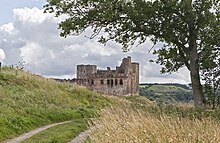Crichton Castle
Crichton Castle is a castle ruin near the source of the Tyne in Scotland near Crichton , Midlothian , south of Edinburgh .
history

In the late 14th century, John de Crichton had a tower house built as a family residence. His son William was raised to the hereditary nobility as Lord Crichton in 1443 and served as Lord Chancellor of the Kingdom of Scotland . After the castle was destroyed in 1445, an act of revenge for William Crichton co-organizing the so-called Black Dinner in 1440, at which the Earl of Douglas was murdered, William had the building restored and expanded. At the same time he built the nearby church.
The third Lord Crichton, a follower of Alexander Stewart, 1st Duke of Albany , lost titles of nobility and lands after his flight to France in 1483. In 1488, Crichton Castle and the Bothwell Castle, which had also been acquired by the Crichtons, were transferred to Sir John Ramsey, who, however, fell out of favor in 1488. The Scottish King James IV gave the former property of the Crichtons to Patrick Hepburn, Lord Hailes, who later became the 1st Earl of Bothwell . Because of the role of James Hepburn, 4th Earl of Bothwell , during the Scottish Reformation, Crichton Castle was besieged and taken by the Earl of Arran on November 3rd, 1560. In 1567, the Earl of Bothwell was involved in the assassination of Henry Stuart, husband of Queen Mary of Scots , (probably the principal) and became her third husband. After Maria Stuart's abdication in June 1567, he lost his title and property in December 1567. This was given to Francis Stewart in 1568, an illegitimate grandson of King Jacob V Stewart, who was inspired by a tour of the continent and had the Italian-inspired north wing of Crichton Castle built in the 1580s according to his own design. Steward received the title of Earl of Bothwell in 1577, conspiring against James VI. and was charged with witchcraft, whereupon he lost title and property. After fleeing to Naples, his son Francis received castles and lands, but suffered from his father's debts and eventually sold Crichton to the Hepburns of Humbie.
In 1956, the last owner, Major Henry Callander, placed Crichton Castle under state administration. The castle, painted by William Turner in the 19th century, is now a " Scheduled Monument " (protected archaeological site) under the administration of Historic Scotland .
architecture
Crichton Castle consists of four connected buildings with a common courtyard. To the east is the 14th century tower with a vaulted foundation and a wooden mezzanine. A vaulted hall is located above it. The southwest corner of the tower has been destroyed. During the expansion in the early 15th century, another south tower was built, which forms an L with the gate between the two towers. Towards the end of the 15th century, the complex was expanded to include a west wing with a six-story tower and the north wing. A special feature of Crichton Castle is the Italian-inspired north facade of the inner courtyard. It goes back to the Palazzo dei Diamanti , built in Ferrara in 1582 . Their surface design with pyramid-shaped projections is reminiscent of diamonds. Inside the complex is Scotland's first two-flight staircase (until then, spiral staircases were common). To the south of the castle is another building whose purpose is uncertain (barn, slaughterhouse or chapel). The ghost of William Crichton is said to haunt this place.
Web links
- Entry on Crichton Castle in Canmore, Historic Environment Scotland database
- Scheduled Monument - entry . In: Historic Scotland .
Coordinates: 55 ° 50 ′ 28 " N , 2 ° 59 ′ 22.2" W.


